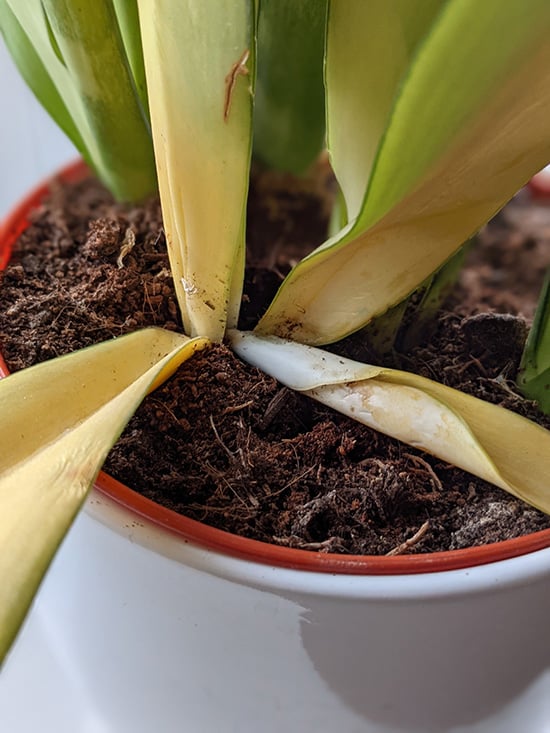Snake Plant Leaves Turning Yellow Can Be Fun For Everyone
Wiki Article
About Snake Plant Leaves Turning Yellow
Table of ContentsThe 6-Minute Rule for Snake Plant Leaves Turning YellowThe Ultimate Guide To Snake Plant Leaves Turning YellowThe Only Guide for Snake Plant Leaves Turning YellowHow Snake Plant Leaves Turning Yellow can Save You Time, Stress, and Money.Some Known Factual Statements About Snake Plant Leaves Turning Yellow
Below are seven factors your serpent plant's leaves might be transforming yellow and how to fix it. Numerous different plant issues can create yellow leaves, or chlorosis. Chlorosis happens when plants do not have the micronutrients they require to produce chlorophyll, that makes foliage eco-friendly and allows plants to convert sunlight right into food.Snake plants are dry spell forgiving thanks to their succulent fallen leaves. Snake Plant Leaves Turning Yellow. These plants expand best in loose, well-drained soil that's permitted to dry out totally in between waterings and might just need water once per month throughout wintertime. Overwatering can protect against roots from soaking up moisture and nutrients that the plant needs and can even create origin rot
A potbound plant can't take in nutrients from the soil. If your serpent plant is chock-full or outgrowing its pot, this might be the cause of yellow fallen leaves. A periodic yellow fallen leave is completely typical for a serpent plant. As the plant ages, old fallen leaves yellow, die, and leave as they're changed with new ones.
Make certain the plant has brilliant, indirect light and consistently cozy temperature levels, and water only as soon as the dirt has actually totally dried out. Watch out for problems and capture them at an early stage to keep your plant looking healthy and attractive.
Unknown Facts About Snake Plant Leaves Turning Yellow
If the leaves on your serpent plant are obtaining soft, it's typically an indication of too much water. Serpent plants shop water in their leaves and if they're overwatered, the leaves can come to be soft and mushy. If you think your serpent plant is being overwatered, enable the dirt to dry entirely before sprinkling once again.Yes, some yellowing is typical and to be expected on older fallen leaves, specifically as serpent plants age. If the plant is or else healthy and balanced and the fallen leaves are only lightly yellowed then there is no cause for worry. If the fallen leaves are significantly yellowed or if there are other indications of distress after that it's finest to take activity.

In basic, snake plants should be watered every one to two weeks. If you assume your snake plant has been overwatered, the initial action is to stop sprinkling it.
Snake Plant Leaves Turning Yellow Fundamentals Explained

The serpent plant is a trendy houseplant. The snake plant is one of those plants that are fantastic for expanding indoors in a terrarium, Snake plants can expand quite large, however they additionally often tend to check these guys out be pretty low-maintenance.
When the soil is overwatered, the plant cells take in more water than they can store. Review below to Leaves ended up being soaked and yellow as they absorb much more water. Sagging serpent plant leaves are brought on by soaked-up fallen leave cells shedding their suppleness. You may discover that your snake plant will certainly come to be black or brownish if the yellow spots are not corrected by dealing with overwatering.
It is, as a result, more probable that your plant will certainly find yellow spots on its fallen leaves if you overfeed it with plant food throughout winter months. The fallen leaves of serpent plants are additionally susceptible to yellowing when overfed, specifically if the origins are vulnerable. Repotting your yellowing, watering only when the soil dries, and giving ideal temperature and light problems can save it.
5 Simple Techniques For Snake Plant Leaves Turning Yellow
To stop yellowing created by overwatering, quit irrigating the snake plant up until the soil totally dries out. Water your serpent plant just when the top 2 inches of soil feel completely dry.Your can be gotten rid of by removing the yellow suggestions - Snake Plant Leaves Turning Yellow. The pruned fallen leaves ought to expand longer if they are sprinkled appropriately and have ideal light and temperature conditions. It is essential to bear in mind that the pointed tips will not regrow, causing them to attract attention from the rest of the continue reading this fallen leaves
It will not take wish for the leaves to regrow and expand like the healthy fallen leaves around them. At the same time, you can remove affected leaves you can try this out from the base of the plant. The indicates that it's obtaining as well much or also little light or nutrients. The crucial message is to enable the serpent plant time to recoup.
Scroll the short article till the end to discover the option. Pay attention to this write-up right here: The situation can be anticipated if you have actually had your serpent plant for a lengthy time, and yellowing occurs on the lower leaves as a natural aging cycle. Also, it prevails for the Sansevieria delegates turn yellow because of novice blunders and when the plant is simply purchased from the nursery for repotting.
Some Of Snake Plant Leaves Turning Yellow
Some of one of the most typical reasons are listed here. Sansevierias like completely dry climates and like little water kept at a void of one or two times once a week in summertime and regular monthly in wintertime. When the water dosage gets out of control, your Sansevieria will certainly experience from overwatering. One of the most common issue issued by overwatering is root rot causing mushy origins and stems with a foul odor.Report this wiki page